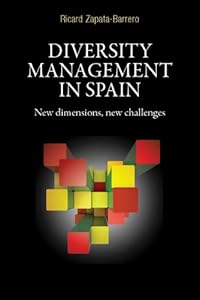 In Diversity Management in Spain, Ricard Zapata-Barrero argues that Spain represents a context of “multiple diversity”, where two frameworks interact: an old, unresolved one, arising from democratic transition, and a new one due to immigration in the twenty-first century. This book reminds us that historical languages and identities also need to be addressed in debates about integration and diversity management, writes Verena Wisthaler.
In Diversity Management in Spain, Ricard Zapata-Barrero argues that Spain represents a context of “multiple diversity”, where two frameworks interact: an old, unresolved one, arising from democratic transition, and a new one due to immigration in the twenty-first century. This book reminds us that historical languages and identities also need to be addressed in debates about integration and diversity management, writes Verena Wisthaler.
 Diversity Management in Spain: New Dimensions, New Challenges. Ricard Zapata-Barrero. Manchester University Press. July 2013.
Diversity Management in Spain: New Dimensions, New Challenges. Ricard Zapata-Barrero. Manchester University Press. July 2013.
Diversity Management in Spain introduces the reader to how immigration, and subsequently integration, are dealt with in Spain. The author, Ricard Zapata-Barrero, Professor of Political Science at Pompeu Fabra University in Barcelona, argues that Spain is challenged by a “multiple diversity” (p. 2). This stems on the one hand from the historical co-presence of diverse nations and languages, such as Catalans, Basques, Galicians, and Roma, which resulted in a decentralized and asymmetric state structure. On the other hand, Spain’s “multiple diversity” is a consequence of recent immigration, in particular from Latin America and Africa. By focusing on the interplay between the historical and immigration-related forms of diversity, the author adds an alternative perspective on migration in Spain to previous scholarship. Extending an argument the author has already applied to the specific case of Catalonia to the whole of Spain, Zapata-Barrero argues that “immigration is not so much a component of diversity… but a vehicle through which existing diversities are brought to the fore” (p. 6).
Consequently, the author claims, the various nations in Spain and their historical identities need to be given much more attention and prevalence in the Spanish migration discourse. This is necessary in order to overcome what the author calls the result of “Spain’s recent past [democratic transition and hegemony of Catholic church] and its different traditions [the nations]” (p. 2), namely “an iron cage, limiting institutional innovation and structural change” (p.2). This argument is made on a theoretical level in the introduction and in chapter one and six of the book. It is also elaborated on an empirical level by presenting a selection of policy discourses related in particular to Muslim communities (chapter 3), and by analyzing various policy fields such as education (chapter 3), the labour market (chapter 4) and political participation (chapter 5).
In the introductory chapter, the author argues that in relation to immigration and integration “Spain has been following a teleological path, centred in concrete aims and dictated by practical conflicts, and always trying to take into consideration the consequences of current conflicts and policy answers to them” (p. 3). This is what Zapata-Barrero calls the Spanish practical approach, a “conflict oriented strategy, but without any clear long-term model of societal identity within the current dynamics of diversity” (p.3). The country thus becomes a “laboratory in a process of definition of its own philosophy” (p. 4).
This practical approach is illustrated in more detail in chapter two: large-scale immigration to Spain started only in the late 1990s and became a major issue only after 2000. Therefore, the distribution of powers in relation to immigration is only broadly defined in the Spanish Constitution of 1978. As a consequence, the management of borders and immigration flows is now exclusive responsibility of the central government, whereas all issues related to integration are in the hands of the autonomous communities and local governments.

This multi-level governance of immigration and integration leads to an individualization of integration strategies on the level of the autonomous community and the local government, with each community highlighting its particular interests. The author argues that in Catalonia immigration is perceived by some as a “potential danger to Catalan culture and identity, especially with regard to the future of the Catalan language” (p. 82). Thus, it is a logical consequence that the Catalan language has gained particular importance in the integration strategies of the Generalitat de Catalunya, the government of Catalonia, and is seen as the main tool for creating social cohesion. In the area of education, for instance, aules d’acollida, so called reception classes, have been set up to teach immigrant pupils the basics of the Catalan language. Immigrant pupils spent up to 50% of their school hours for a maximum of two years in those classes in order to better learn the language. Migration and integration are also central to the Catalan Language and Cohesion Plan of 2007, which states that “all schools should ideally have between 10 and 30 per cent immigrants” (p.86), because “[a] concentration of immigrants greater than 30 per cent creates management problems, while less than 10 per cent means giving pupils a limited vision of our globalized world” (p. 86) and thus interprets diversity as an enrichment. Yet, other languages such as the language of origin, or religions other than Catholicism, are not part of the official school curriculum. Zapata thus interprets the Catalan approach as coming “closest to the French civic assimilationist model, with Catalan as the main tool for fostering civic identity among its resident citizens, although there are important differences” (p. 90).
Presenting the example of Catalonia, the author shows that “in those communities where a second official language is promoted (like Catalonia, the Basque country, and Galicia) immigration represents a challenge to identity politics and has resulted in specific challenges of how to manage bilingualism and now multilingualism in schools” (p. 92).
This is also the key message of the book: Spain implements an inductive conflict-driven approach to diversity rather than a theory-driven approach. This is a result of Spain’s multi-level governance of integration, and of the interaction of the two diversity frames: the ‘old’ type of diversity, based on the hegemony of the Catholic church and the co-existence of various nations within one state, and the ‘new’ form of diversity, as a result of the large immigrant influx in the first decade of the 2000s.
While the author focuses on Spain as a convincing illustrative example for a case where different dynamics of diversity frameworks interact, the book’s argument can also be applied to other European countries, such as the UK, but also Belgium or Italy. Indeed, Europe itself could be regarded as such a case. The book is not only topical, but it also highlights a dimension, which is seldom forgotten yet central to effectively dealing with diversity: namely, that immigration is a central dimension of diversity but not the only one, and local “autochthonous” or historical languages and identities also need to be addressed in debates about integration and diversity management.
————————————–
Verena Wisthaler is a Junior Researcher at the Institute for Minority Rights at European Academy of Bozen/Bolzano and a PhD student at the University of Leicester. She is particularly interested in nationalism, cultural diversity and minority rights. Read more reviews by Verena.







1 Comments